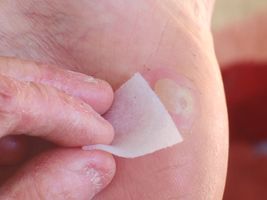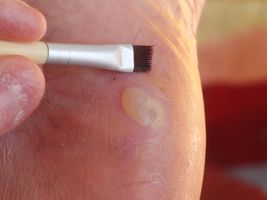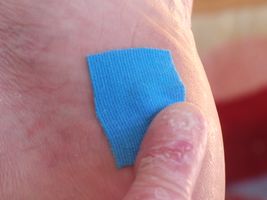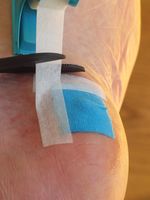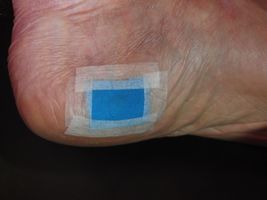Difference between revisions of "Taping"
User:Fellrnr (User talk:Fellrnr | contribs) m (→Also See) |
User:Fellrnr (User talk:Fellrnr | contribs) |
||
| Line 20: | Line 20: | ||
==Adhesive Remover== | ==Adhesive Remover== | ||
* '''Detachol<ref>Eloquest Healthcare Detachol http://www.eloquesthealthcare.com/products/detachol.aspx</ref>''' This adhesive remover works great for removing tape, especially around blisters. You still have to be careful, easing up the edges and applying some of the detachol, but it's quite easy. I use a cotton bud to rub the detachol at the point where the tape meets the skin. It seems to leave no residue or upset the skin in any way. | * '''Detachol<ref>Eloquest Healthcare Detachol http://www.eloquesthealthcare.com/products/detachol.aspx</ref>''' This adhesive remover works great for removing tape, especially around blisters. You still have to be careful, easing up the edges and applying some of the detachol, but it's quite easy. I use a cotton bud to rub the detachol at the point where the tape meets the skin. It seems to leave no residue or upset the skin in any way. | ||
| + | ==How to tape a blister== | ||
| + | This is the taping technique I generally use. For minor issues, just Micropore works well, but for a something more delicate, the combination of Kinesio-Tex and Micropore is better. | ||
| + | <gallery widths=300px heights=200px caption="Taping a blister"> | ||
| + | File:Blister - Clean.jpg|Clean the blister area with an alcohol wipe. This is important so the skin is clean for the adhesive to stick. | ||
| + | File:Blister - Adhesive Promoter.jpg|Apply an adhesive promoter '''around''' the blister, not on the blister itself. You can even put a small amount of lubricant on the blister itself so the tape doesn't stick to the blister. If you get the adhesive promoter on the blister, removing the tape is likely to tear the blister. | ||
| + | File:Blister - Apply Tape.jpg|Cut the Kinesio-Tex tape a little larger than the blister. Bigger gives more sticking area, which is good, but the extra coverage can cause that skin to become saturated with sweat, so it's a compromise. Push down on the tape around the blister to make a good seal. You're looking to create pressure and a little heat. | ||
| + | File:Blister - Taped.jpg|Here is the blister with the Kinesio-Tex in place. | ||
| + | File:Blister - Extra Adhesive.jpg|Now apply more adhesive promoter around the Kinesio-Tex tape and a little on the edge of the tape itself where the Micropore will go. | ||
| + | File:Blister - Apply Micropore.jpg|Apply Micropore around the edges of the Kinesio-Tex to stop it from pealing up. | ||
| + | File:Blister - FInished.jpg|Here is the finished version. It's a good idea at this point to put some powder over the area so that any excess adhesive promoter doesn't stick to your sock and cause problems. | ||
| + | </gallery> | ||
| + | |||
==Also See== | ==Also See== | ||
* [[Book Review - Fixing Your Feet|Fixing Your Feet]] is a great book that includes details of taping | * [[Book Review - Fixing Your Feet|Fixing Your Feet]] is a great book that includes details of taping | ||
| Line 26: | Line 38: | ||
* [[Blister Prevention and Socks]] | * [[Blister Prevention and Socks]] | ||
* [[Toughening Feet]] | * [[Toughening Feet]] | ||
| − | |||
==References== | ==References== | ||
<references/> | <references/> | ||
Revision as of 17:15, 4 November 2011
Taping may be required to prevent blisters or if they occur anyway, to help treat them. Different tapes have different properties, and it's best to gain experience with different tapes before using them in a race. Even putting a piece of tape on the edge of your hand will give you an idea of how well it stick and how flexible it is.
Contents
[hide]1 General Taping Tips
- Practice taping for your training runs – remember The Golden Rule of Racing
- Tape a couple of days before the race to check that the taping is working well.
- Remember your feet may swell so avoid taping too tightly.
- If you get a blister, taping can prevent it getting worse and can relieve the pain.
- Taping a blister can create more pressure on the blister if done incorrectly.
- Popping a blister that has been taped is far harder, so think ahead. Popping a blister is a bad idea, but sometimes it's necessary if the blister will spread.
- Taping should be a last resort; try to fix the underlying problem first.
2 Tapes
- Micropore[1] This is my default tape, partly because I have been using Micropore from my earliest memories due to my skin condition. Micropore is very thin, smooth and inflexible, but not very sticky, so you need to use it with an adhesive promoter. The biggest problem with Micropore is that it is not very durable. I find it will last well enough for a race, but I like to tape a day or two ahead of time to make sure the tape is right, and it can suffer wear in the mean time.
- Leukotape P [2] This is thicker, slightly rough textured, inflexible tape. It works very well when you need something more robust than Micropore.
- Elastikon[3] This tape is thicker than any of the others, slightly rough, but flexible and porous.
- Kinesio-Tex This is a soft tape that stretches in one direction. I find that it does not stick well without an adhesive promoter, though rubbing the tape to warm it before applying will help it stick a little better. I also find the edges tend to fray, so I will often use some Micropore to stick the edges down.
- Duct Tape I strongly recommend against using duct tape, as it is not breathable, so the skin tends to become saturated underneath. Duct Tape also tends to wrinkle, creating creases that cause further problems. Like many other tapes, you need to use it with an adhesive promoter to get it to stick effectively. Watch the edges, as they tend to catch and then the tape then rolls up. I have used Micropore on the edges, with some success.
3 Adhesive Promoter
- Friar's Balsam[4] Also known as Tincture of Benzoin, this helps tapes stick much better. I find it important to apply the balsam to the area where the tape is going to be placed; If you miss a spot, then the tape will tend to lift up in that spot. If you over apply it, you can remove the excess with rubbing alcohol or smother it with talcum powder.
- Mastisol[5] This is seems to work better than Friar's Balsam – it is claimed to be 7-10 times sticker. I'm not sure if that is true, but it does work remarkably well. Easy to apply, but expensive!
4 Adhesive Remover
- Detachol[6] This adhesive remover works great for removing tape, especially around blisters. You still have to be careful, easing up the edges and applying some of the detachol, but it's quite easy. I use a cotton bud to rub the detachol at the point where the tape meets the skin. It seems to leave no residue or upset the skin in any way.
5 How to tape a blister
This is the taping technique I generally use. For minor issues, just Micropore works well, but for a something more delicate, the combination of Kinesio-Tex and Micropore is better.
- Taping a blister
Cut the Kinesio-Tex tape a little larger than the blister. Bigger gives more sticking area, which is good, but the extra coverage can cause that skin to become saturated with sweat, so it's a compromise. Push down on the tape around the blister to make a good seal. You're looking to create pressure and a little heat.
6 Also See
- Fixing Your Feet is a great book that includes details of taping
- Blister Prevention
- Popping Blisters
- Blister Prevention and Socks
- Toughening Feet
7 References
- Jump up ↑ http://www.zombierunner.com/store/categories/foot_care/tapes/product6.html Micropore at Zombie Runner
- Jump up ↑ http://www.zombierunner.com/store/categories/foot_care/tapes/product967.html Leukotape P at Zombie Runner
- Jump up ↑ http://www.zombierunner.com/store/categories/foot_care/tapes/product1.html
- Jump up ↑ http://www.zombierunner.com/store/categories/foot_care/adhesives/product125.html Friar's Balsam/Tinture of Benzoin at Zombie Runner
- Jump up ↑ http://www.zombierunner.com/store/categories/foot_care/adhesives/product1026.html Mastisol at Zombie Runner
- Jump up ↑ Eloquest Healthcare Detachol http://www.eloquesthealthcare.com/products/detachol.aspx
